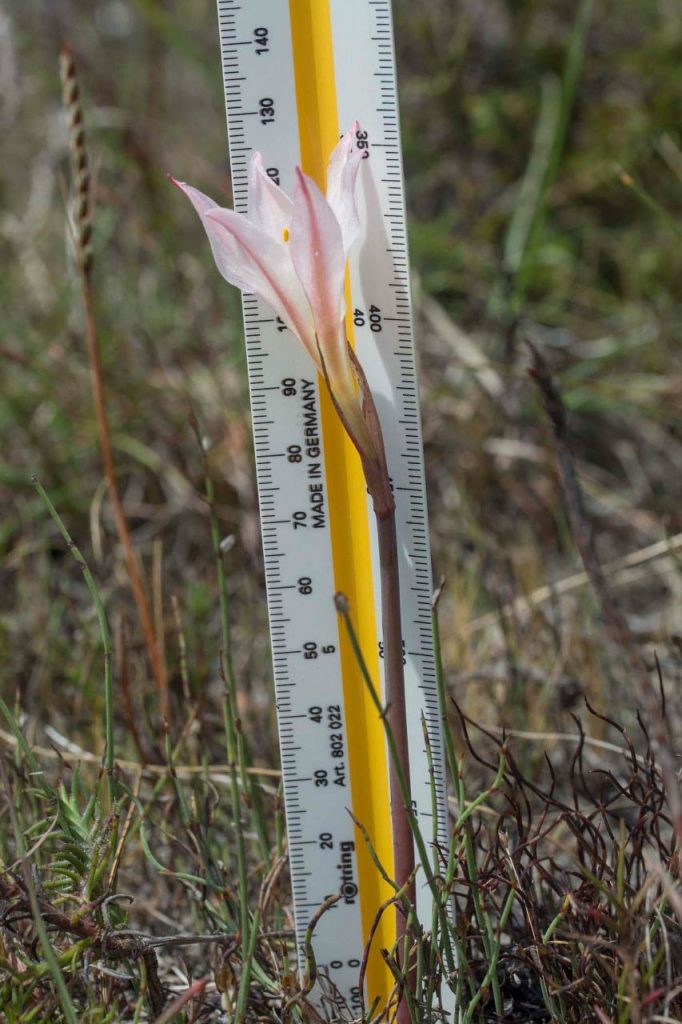Nuwejaars lily
A new fynbos lily species, the Nuwejaars lily (Cyrtanthus novus-annus), has been discovered in a conservation area on the Agulhas Plain, a biodiversity hotspot.
The soft pink and white flowering plant has only been found in two locations, both in the Nuwejaars Wetlands Special Management Area, which is located within the Agulhas Plain at the southernmost tip of Africa.
“We are very excited,” said Ross Kettles, the project manager for the special management area. “It just goes to show that with all the doom and gloom going on in the world, every now and then we still have some good news.”
With fewer than 250 plants in total, covering an area of less than 5km², it’s likely that once assessed, the new Cyrtanthus will be classified as endangered on the South African National Biodiversity Institute (Sanbi) Red List.
The unexpected discovery was made in 2019. “We were planning a route for an environmental education trip for some school kids and we came across this flower on a farmer’s farm,” said Kettles. “We just thought it looked a little bit different. It looks very similar to the Bredasdorp lily, which is critically endangered, but the colour was a little bit different and there were slight differentiations so we got the ball rolling.”
A series of events, including the Covid-19 pandemic lockdowns, put the discovery on hold. Then, late last year, the area’s conservation team stumbled upon another flowering population. “Of course, we couldn’t say anything because we needed to have it scientifically proven and analysed,” he said.
With the help of the Botanical Society of South Africa’s Rupert Koopman, experts including Dee Snijman and John Manning were brought in to undertake a complete assessment earlier this year.
Snijman, a Cyrtanthus expert, has now released her scientific paper describing the new species. “The species epithet honours the recent restoration of biodiversity in the Nuwejaars Wetlands area,” Snijman said in a statement.
“This is a great story which highlights how special the Overberg is in terms of plant diversity,” said Koopman, in the statement. “And, in fact, how special the fynbos biome is in general, considering that we are still picking up new species even in areas that are well known.”
The new species occurs on low, open vegetation, which includes elements of Central Rûens Shale Renosterveld and Elim Ferricrete Fynbos. Both are critically endangered.
“It also shows the importance of the integration of the botanical community,” said Koopman. “This species went from the Nuwejaars conservation team, through a series of botanical experts; I acted as a courier to Sanbi’s taxonomist to ultimately describe the species. This outcome — that the species is now formally described and can be assessed to receive a red list status — is essential.”
In a botanical twist, the Cyrtanthus novus-annus is seen as a sister species to the Bredasdorp lily, given their resemblance and their reasonably close proximity to each other. The Bredasdorp lily only occurs on the Overberg mountains.

The conservation area covers 47 000ha and includes critically endangered fynbos and irreplaceable wetlands and rivers crisscrossing the landscape. The farmers, who are members of the Nuwejaars Wetland Special Management Area, have appointed a team of conservationists to help restore and manage these land and waterscapes.
Last year, in another scientific breakthrough, the biggest population of critically endangered micro frogs were found in the conservation area.
“We’re finding things all the time here that are fascinating,” Kettles said. “We are focusing more on research of new species … and we’re going through almost every square inch of indiginous bush here looking for new species and trying to identify endangered species and knowing where they are so that we can protect them.”
The Nuwejaars lily, he added, would never have been recognised as a new species, were it not for the conservation work in partnership with its farmer-members. This is a unique model.
“Farmers continue to farm, but at the same time we can’t lose what’s left of our biodiversity here. Farmers here have therefore made the ultimate commitment to this protection, signing title deed restrictions to protect our natural world in perpetuity.”
[/membership]